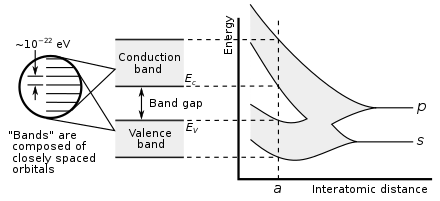ബാന്റ് ഗ്യാപ്
ദൃശ്യരൂപം

സോളിഡ് സ്റ്റേറ്റ് ഫിസിക്സിൽ ബാന്റ് ഗ്യാപ് (band gap, energy gap, അല്ലെങ്കിൽ bandgap) എന്നെല്ലാം അറിയപ്പെടുന്നത് ഒരു ഖരത്തിൽ ഇലക്ടോണുകൾക്ക് സ്ഥിതി ചെയ്യാൻ സാധ്യമല്ലാത്ത ഒരു ഊർജ്ജ മേഖലയെയാണ്.
സെമികണ്ടക്ടർ ഫിസിക്സിൽ
[തിരുത്തുക]
ബാന്റ് ഗ്യാപ്പുകളുടെ പട്ടിക
[തിരുത്തുക]| Group | Material | Symbol | Band gap (eV) @ 302K | Reference |
|---|---|---|---|---|
| III-V | Aluminium nitride | AlN | 6.0 | [1] |
| IV | Diamond | C | 5.5 | [2] |
| IV | Silicon | Si | 1.14 | |
| IV | Germanium | Ge | 0.67 | [3] |
| III–V | Gallium nitride | GaN | 3.4 | |
| III–V | Gallium phosphide | GaP | 2.26 | |
| III–V | Gallium arsenide | GaAs | 1.43 | |
| IV–V | Silicon nitride | Si3N4 | 5 | |
| IV–VI | Lead sulfide | PbS | 0.37 | |
| IV–VI | Silicon dioxide | SiO2 | 9 | [4] |
| Copper oxide | Cu2O | 2.1 | [5] |
പദാർത്ഥങ്ങൾ
[തിരുത്തുക]ഇലക്ട്രോണിൿ വിഷയങ്ങളുടെ പട്ടിക
[തിരുത്തുക]- Electronics
- Bandgap voltage reference
- Condensed matter physics
- Direct and indirect bandgaps
- Electrical conduction
- Electron hole
- Field-effect transistor
- Light-emitting diode
- Photodiode
- Photoresistor
- Photovoltaics
- Solar cell
- Solid state physics
- Semiconductor
- Semiconductor devices
- Strongly correlated material
- Valence band
ഇവയും കാണുക
[തിരുത്തുക]അവലംബം
[തിരുത്തുക]- ↑ Feneberg, Martin; Leute, Robert A. R.; Neuschl, Benjamin; Thonke, Klaus; Bickermann, Matthias (2010). "High-excitation and high-resolution photoluminescence spectra of bulk AlN". Physical Review B. 82 (7). doi:10.1103/PhysRevB.82.075208. ISSN 1098-0121.
- ↑ Kittel, Charles. Introduction to Solid State Physics, 7th Edition. Wiley.
- ↑ Streetman, Ben G.; Sanjay Banerjee (2000). Solid State electronic Devices (5th ed.). New Jersey: Prentice Hall. p. 524. ISBN 0-13-025538-6.
- ↑ Vella, E.; Messina, F.; Cannas, M.; Boscaino, R. (2011). "Unraveling exciton dynamics in amorphous silicon dioxide: Interpretation of the optical features from 8 to 11 eV". Physical Review B. 83 (17): 174201. Bibcode:2011PhRvB..83q4201V. doi:10.1103/PhysRevB.83.174201.
- ↑ Baumeister, P.W. (1961). "Optical Absorption of Cuprous Oxide". Physical Review. 121 (2): 359. Bibcode:1961PhRv..121..359B. doi:10.1103/PhysRev.121.359.
പുറത്തേക്കുള്ള കണ്ണികൾ
[തിരുത്തുക]- Direct Band Gap Energy Calculator Archived 2008-05-15 at the Wayback Machine.
- Moriarty, Philip. "Energy Gap (and what makes glass transparent?)". Sixty Symbols. Brady Haran for the University of Nottingham.
